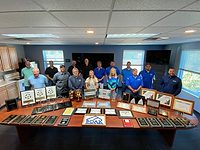Douglas J. Wooliver started roofing homes and businesses in the midst of the Industrial Revolution in central Massachusetts and became successful enough as a roofing contractor to leave behind a quality name and reputation four generations later. And when you grow up in a strong roofing family with established community roots, there isn’t much choice — or desire — to become anything else when it came to choosing a career path.
At least that’s how Matt and Chris Wooliver look at it.
“Our father basically had us work summers from the age of 12,” said Matt, current vice president of D.J. Wooliver & Sons, Inc. “We would help with deliveries, sweep the floors, organize the slate pallets, etc. There wasn’t much negotiating as far as looking for other summer employment.”
If that sounds like a familiar story for roofing companies comprised of multiple generations of the same family, it’s because it is. Just ask Matt’s father, Mike Wooliver, who took over sole command of company operations after his father, Phillip “Tink” Wooliver, died in 2001.
Going back as long as he can remember, Mike said he always wanted to work with his father. He vividly recalls working on his first roofing job at the now-closed Berkshire Downs Race Track located in Hancock, Mass. in the summer of 6th grade.
“I was carrying rolls for the crew, and nails because back then they were putting nails down on bay sheets,” he said. “I actually never wanted to do anything else (other than roofing).”
Mike’s interest in the family business continued to grow as a teenager. As a freshman, he enrolled in Taconic High School’s vocational program specializing in sheet metal work. As a junior and senior, he spent every other weekend working at the company, and upon graduating in 1972 was given a choice: go to college or start at the very bottom in the family business.
He told his father he wanted to work for the company, to which Tink replied, “That’s fine, you don’t have to go to college, I’ll take you to the school of hard knocks,” Mike said. Ever since, he’s never spent a day working for anybody else.
Old-School Origins
Company founder and namesake Douglas (D.J.) Wooliver started roofing with one method of transport — a horse and wagon — and ran operations out of his house in Pittsfield, Mass., not far from the New York state border. The majority of business was in built-up roofing and his shop used chicken coops and old barns for storage. At the time, significant business expenses included horse feed and animal care.
That house remained company headquarters long after D.J.’s son, Stephen, took over operations in the mid-1940s. Under his leadership, the company moved to nearby Lanesborough — just a short drive north along U.S. 7 — in 1971. They still worked the old-fashioned way in several respects. For example, the company’s first dump truck — an old fire engine repurposed for hauling waste and discarded materials — wasn’t purchased until 1974. But they began to catch up with the times.
In Lanesborough, the Woolivers found the space and ability to grow, adding a 5,000 square-foot warehouse in 1988 and full-service metal fabrication shop needed to accommodate the influx of business coming not just from western Massachusetts, but also New York and Vermont.
Stephen, who was well known in the community and business circles for his charitable work, remained actively involved in the family business until he died in 1983.
By that time, the company was known for its expertise in multiple forms of roofing, including: single ply; slate; architectural sheet metal; wall cladding, and standing seam comprised of copper, zinc, steel and aluminum.
Since then, the company has added comprehensive waterproofing and sheet metal fabrication (including custom metal breaking for a variety of uses such as through-wall flashings, chimney caps, edge metal, wall cladding, and custom built gutters) to its service offerings. The company also grew a maintenance department that’s versatile enough to tailor services to each building owner or facility manager’s needs, whether for just one structure or an entire campus. Those services include roof asset management programs; infrared scans; 24-hour emergency services; CAD roof plans and detailed drawings; and budget development on one, three, or five-year tracks. The department also handles all retrofit roof needs including HVAC curb replacement/installation/removal, pitch pocket installation, and on.
The percentage of business between new and reroofing jobs fluctuates annually based on the market, Matt said, but typically hovers around 60 percent reroof, and 40 percent new construction.
The company moved outside of its traditional geographic ‘comfort zone’ in 2012 by purchasing Doxsee Roofing Inc. in Bennington, Vt. Doxsee launched in 1983 and spent nearly three decades building a strong reputation in the market for standing seam products and fabricated accessories, such as edge metals and screened and ventilated ridge caps; single ply membranes; copper batten seam and flat seam products — including batten and flat seam soldered roofing, copper roofs, copper bell towers, and copper domes.
Today, the company specializes in interior and exterior applications for new construction and historic renovations of both public and private educational facilities, commercial and industrial structures, medical and healthcare facilities, and large residential projects.
Both D.J. Wooliver Co. and Doxsee operate as separate entities but have shared services including accounting, some insurance coverages, equipment, and even employees — as each company sub contracts the other’s workforce at times. Both companies have sloped and flat divisions, as well as a maintenance division.
The New Blood
Maintaining versatility is an important aspect of the company’s present and future plans, and a cornerstone trait of Wooliver’s fifth generation of leaders. Like most employees, Chris, now 37, was cross-trained in multiple aspects of the roofing business when he decided to join the company out of high school. He spent the first five years as a laborer in the field and learned the single-ply trade before moving into the slate and copper (sloped) side of operations.
Matt, now 34, followed a different, yet related path. After working on roofs during summers throughout high school and college, he started a company flipping houses. When the housing market crashed and profits evaporated, Mike offered him a full-time job. He began working on flat roofs, splitting his time between field work in the mornings and learning the behind-the-scenes parts of the business in the office in the afternoons.
After about six months, he said the schedule became too difficult to juggle and he focused solely on the managerial side of the company.
Despite the roofing company’s deep roots and century-worth of experience, both Chris and Matt said they’ve witnessed a strong ability to adapt.
That became clear during the Great Recession, when the well of new roofing projects dried up and many roofing companies looked to reinvent themselves. Those that couldn’t closed up shop. Since the economy started to nosedive in mid-2008, the company bid on more public work because that’s where the opportunities were. But the Woolivers also developed their overall service and maintenance efforts.
“By focusing on this side of the business, rather than just doing repairs as fillers and poor weather alternatives, we were able to develop new relationships that helped grow the business on the production side,” Chris said.
Training, Education and Culture
In addition to adaptability, D.J. Wooliver & Sons maintains its success by emphasizing safety, continuing education and quality work. The company screens employee candidates for potential safety issues prior to making offers, and requires safety orientation as part of the 60-day probationary period for every new hire. A full-time safety director is on staff to ensure the comprehensive safety orientation includes fall protection training, harness fitting and the key components of OSHA-10 certification.
Upon completing the probationary period, new hires then participate in OSHA-30, ACM handling and disposal, and CPR training. The OSHA training is specifically tailored to the roofing industry and has positively impacted the company’s overall incident rate and EMR rating, Matt said. Toolbox talks that review ‘near-misses’ and jobsite hazards occur weekly.
In addition to the safety training, each new employee goes through “Roofing 101,” offered by the National Roofing Contractors Association. Company leaders also set up day-long classroom workshops and hands-on training with all of the manufacturers they work with during the off-season. Attendance for the annual sessions is mandatory.
“These seminars keep us up-to-date with new products and changes to technical requirements from the specific manufacturer,” Chris said. “It also gives the newer employees hands-on training so that they can flash a curb, heat weld a seam, install edge metal, and more.”
Every project goes through some form of pre-job planning that can range from extensive on complicated jobs, to written site-specific safety plans on projects that require a lesser scope of work.
The estimator reviews the project with the project manager and then the foreman. Once reviewed, any project over $150,000 goes through a “stand and deliver” process, which includes presentations to all three Woolivers.
That attention to detail was instrumental in successfully completing a few of the company’s more recent high-profile jobs.
The Stetson Library was a $1.72 million project that featured slate tiles and a copper built-in gutter on a Sarnafil PVC membrane roof. They replaced the concrete deck, installed a zinc standing seam, zinc wall cladding and slate wall cladding. Also part of the project was an annex building where zoning requirements forced the mechanical systems to move from the 6th floor to the roof. That meant flashing more than 300 penetrations in a 4,800 square-foot roof area.
The company also replaced the roof on the Mother-Baby Unit at the Berkshire Medical Center in 2012. The critical unit remained open and functional during the roof replacement, which required working off hours, stopping work without notice for unknown durations, and the replacement of an enormous HVAC unit and all of the exterior duct work. Wooliver said the project had its challenges but that the hospital staff was happy they successfully replaced the roof with minor disturbance to the mothers and babies below.
“Our goal is to challenge the project manager and foreman and ensure that they’ve worked through all of the pitfalls and customer concerns,” Matt said of their pre-job preparation. “We strongly believe having the owners on the projects on a regular basis creates a level of accountability from the employees and a level of comfort for the customers.”
That includes Mike, who even at age 62, is in his element on the roof and is rarely ever talked down by his sons or coworkers.
“I’m not much good on the computer, so I’d just as soon get a (roofing) job, get some guys and go do it,” he said.
The younger Woolivers said it’s also had an effect on company morale.
“When it’s 90-100 degrees out and the owner is there shoulder-to-shoulder doing the same job as you are, as an employee, you’re much more likely to keep working hard,” Matt said.
It also helps build trust with customers. The roofing projects themselves may be complicated, but the Woolivers’ formula for success is rather simple: stay honest and be informative.
“The more trustworthy you are, the more comfortable and happy your customer will be,” Matt said. “So much of what we do is based on the relationships that we build. It’s within your power to have those relationships help you or hurt you.”








Report Abusive Comment